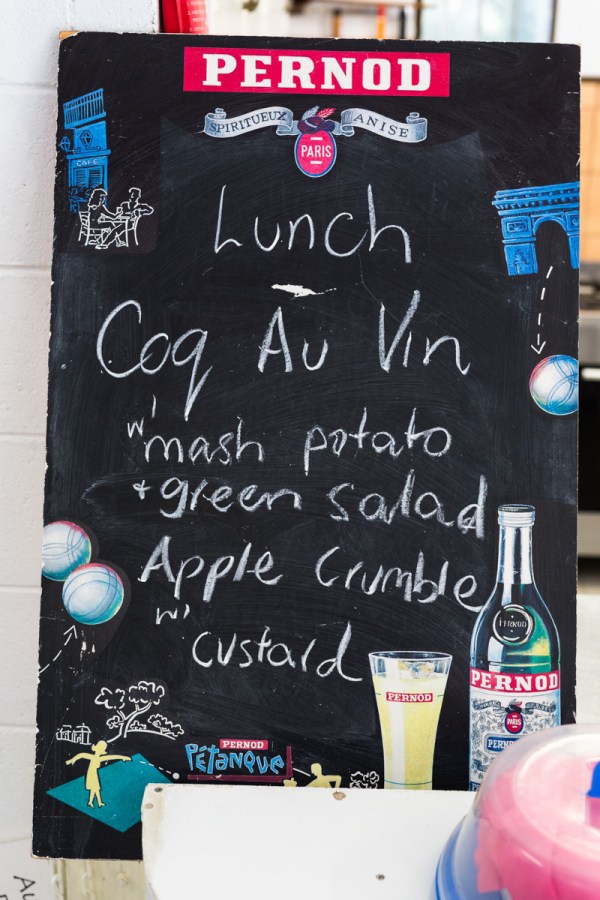A sport that marries laziness and sophistication with a two-course lunch in the name of social inclusion is a game we can get around.
Knock knock – time for pétanque
Across the road from Whistle and Flute on Greenhill Road is a drab besser block building formed in the quintessential brutalist style of so much Adelaide City Parklands architecture.
It sits low, just a single storey, and is dwarfed by century-old eucalypts on all sides.
If you’re keen for a few ends, you can find contact details for the Club de Petanque d’Adelaide here.
From across the road a large sign is legible: Club de Pétanque d’Adelaide.
As we set out, crossing the four-lane road towards our destination, a sprightly woman in a royal-blue and crimson-red ensemble joins our party.
Judith is heading to the same place we are. It’s “bring a novice” day at the Adelaide Pétanque Club. But of course Judith is no novice.
“I’ve been playing for 30 years,” she says with a lilt in her voice that could well imply she’s been at this longer than we’ve been alive.
After we explain where we’re from and that we’ve been alive just longer than she’s been playing, Judith proceeds to give us the dot point briefing on the club and its glorious sport of large metal balls, little pigs and Pernod pours.
The Greenhill Road club was the first established in Australia, “it was opened in 1977,” Judith says.
“It’s the most French club too,” says former club president-turned-secretary Tina Stockley, greeting us warmly as we enter the clubrooms.
Tina isn’t necessarily referring to the number of French national members but rather the club’s aesthetics and traditions.
The drab exterior certainly falls away once you’re inside surrounded by fresh white walls, blue steel trusses and, of course, a splash of red.
There are pennants too – many of them – proudly hanging on walls and from window frames.
“I think we’ve won more than that,” says Claudia Wright – CityMag’s teammate for the day’s matches, which are called ends in Pétanque.
We set down our fees – a mere $7 to play all day. A two-course lunch will cost you just $8 more – a meagre price for Coq au vin and apple crumble.

Before play begins we receive our team pairings and instructions to complete three games – the winner determined as the first-to-13 points – before coming in for lunch. More games will follow the food.
Pétanque is a wonderful game and easy to play. What’s difficult, when in the presence of the practised, is winning. We lose our first two games 13-0.
Each game consists of several ends, where a small wooden ball called the cochonet (translated: ‘piglet’) is tossed a distance of between six and 10 metres. Teams then take turns tossing large steel boules as close as they can to the cochonet. Whoever gets closest to the wooden ball wins the point.
Each time we think we’ve done well, a member from the opposing team steps up and shoots out our closest boules, crack! In one instance our team goes from holding point (winning) to losing by five points due to our opponent’s sniper-like accuracy with the boule.
“Pétanque was actually created from boules,” says Claudia as we march solemnly from one failed end to start the next. “A man had become disabled and asked his brother to come up with a game he could play. In boules you take a run up before throwing the ball much farther. Pétanque literally means ‘with feet together’.”
Claudia demonstrates – knocking her ankles together, bending her knees and taking her shot.
You can see the spirit of that innovation here. The inclusiveness of the game is what makes it so much fun and so sustainable.
Pétanque involves everyone, people of various ages and abilities, men and women together on the same team, in the same league; all laughing and applauding teammates as well as opposition.
It’s the physical embodiment of les trois coleurs: liberty, equality and fraternity. And it’s heaps of fun.
The only way you could make it better would be with a glass of Pernod in your hand.
“After lunch,” Claudia informs us. “Usually we have a glass of wine or Pernod on the piste.”













